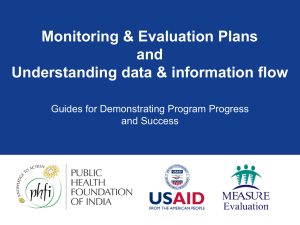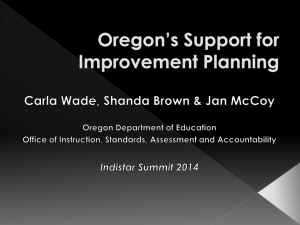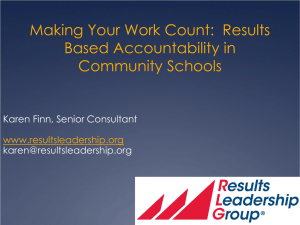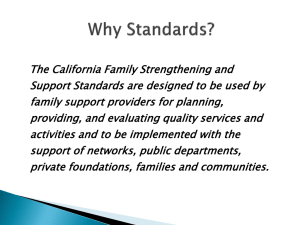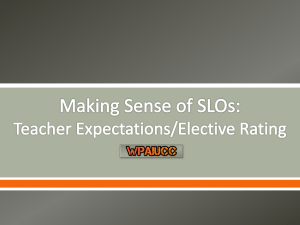Integrating Environmental Safeguards into USAID Food
advertisement
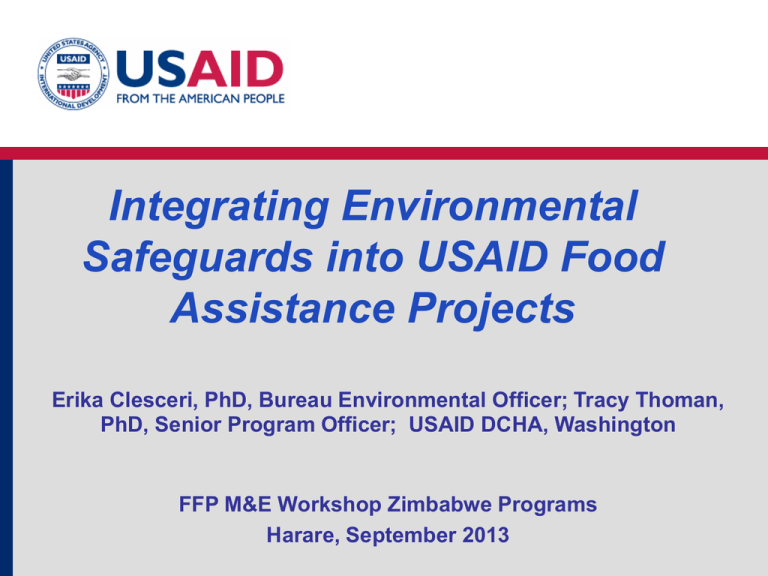
Integrating Environmental Safeguards into USAID Food Assistance Projects Erika Clesceri, PhD, Bureau Environmental Officer; Tracy Thoman, PhD, Senior Program Officer; USAID DCHA, Washington FFP M&E Workshop Zimbabwe Programs Harare, September 2013 Session Timetable 5 min: Quickfire Challenge 40 min: Plenary Presentation Coffee Break 60 min: Break-Out Exercise 15 min: Plenary Stakeholder Feedback Session Objectives By the end of this session, you will have: 1. Discussed two types of USAID recommended environmentally-sensitive indicators. 2. Identified opportunities for “greening” the project results frameworks and indicator systems. 3. Learned about innovative approaches for environmental monitoring. Quickfire Challenge (5 min): Question: How are the environment and food security related? Climate, Environment and Resiliency How is environmental degradation and climate risk related? Source: Adapted from IPCC 2012, Swiss Agency for Development and Cooperation (SDC) Causal Linkages between Food Availability and the Environment Soil Poor Nutrient Agricultural Poor Soil Mining Inputs Water Retention Salinization Poor Soil Fertility Erosion Drought, Desertification and Climate Changes Ineffective Pesticide Use Poor Crop Production Water Shortage Lack of Irrigation Poor Maintenance of Irrigation Canals, Water Use Conflict ClimateSmart Agriculture Food Insecurity Reliance on groundwater likely to increase… African groundwater resources poorly understood…. 7 Environmental Resilience Thinking What ecological goods and services are needed for this project? Are fuelwood stocks for cooking food aid in Zimbabwe well managed? What harm (wastes or damage) to natural resources might result? Will roads increase deforestation and erosion in Zimbabwe? What are impacts of the environment (floods, droughts) on the project? Is physical and social infrastructure capable of responding to flooding? 8 Goals for Sustainability The goal of Title II projects is to reduce food insecurity during the project. Communities will need to sustain their natural resources to support food security for generations to come… "Anybody can dig a hole and plant a tree. But make sure it survives. You have to nurture it….“ -Wangari Maathai, Nobel Laureate (1940-2011) 9 Environmental Safeguards & Compliance Initial Environmental Examination (IEE) is… A formal analysis that identifies: • Potential impact of projects on the environment IEE • Measures to mitigate these impacts Environmental Mitigation Monitoring Plan (EMMP) is… A formal plan that identifies: • Indicators • Frequency and Persons responsible EMMP What is the Purpose of the EMMP? It is a management plan for Environmental safeguards, which are linked to project results and indicators. Activity for IR X.X Potential Impact Monitoring Indicator Frequency of Data Collection Method of Verification Well rehabilitation Ground water contamination Wells Distanced from latrine Monthly by Field Agents Visual Inspection, Field Reports Requirement in the FY13 Request for Application (RFA) for Zimbabwe Projects “The M&E Plan should include gender and environmental indicators to permit the measurement of food security gains while promoting gender equity and safeguarding environmental goods and services.” 12 Food for Peace Results and Indicator Frameworks Results Framework (RF) Indicator Performance Tracking Table (IPTT) Cross Walking M&E with the EMMP… 1. Identify results in the RF that have an environmental component. 2. Compare results with analysis conducted in the EMMP. 3. Reflect the EMMP analysis in the IPTT indicators, where practicable. OK…, how? 14 FFP Results Framework Food Security Improved Assumptions SO1: Resiliency Improved IR 1.1: Protect Communal Assets IR 1.2: Disaster Risk Management Improved SO2: Health and Nutrition Improved IR 2.1:Consume Nutrient Rich Diet IR 2.2: Water and Sanitation CROSS-CUTTING ISSUES: Gender, Capacity Building 15 Environmental Issues Annotated for the RF Title II IR EMMP Issues IR 1.1: Protected Communal Assets (Roads, Agriculture/Irrigation) Roads: Erosion, Wash Out, Protected Area Encroachment, Conflict over Access IR 2.1: Nutrient Rich Diet Nutrition/Health: Biomass Energy, Medical Waste (vaccinations) IR. 2.2: Water and Sanitation Water: Poor Well/Latrine Construction, Water Contamination, Ground Water Drying, Poor O&M All: Direct Distribution Fumigant Pesticides, Fuelwood, Solid Waste 16 Greening the FFP Results Framework Food Security Improved Assumptions SO1: Resiliency Improved IR 1.1: Protect Communal Assets IR 1.2: Disaster Risk Management Improved SO2: Health and Nutrition Improved IR 2.1:Consume Nutrient Rich Diet IR 2.2: Water and Sanitation CROSS-CUTTING ISSUES: Gender, Capacity Building, Environment 17 What does it mean in practice to have Environment as a cross-cutting theme in Food for Peace results and indicator frameworks? 18 What are some Environmentally-Sensitive Indicators? As for Gender, we have two types: 1.Stand-Alone Indicator. 2.Integration Indicator. 19 Purpose of Environmentally-Sensitive Indicators? 1. Stand-Alone Environmental Indicators To measure progress towards planned project environmental results, throughout the life of the activity. E.g., For Climate Change and Natural Resources Management But this alone is not enough… 20 Purpose of Environmentally-Sensitive Indicators? 2.Environmental Integration Indicators To measure progress towards planned project results while incorporating environmental mitigation measures, throughout the life of the activity. E.g., For Irrigation, Roads, Water, Sanitation, etc. A typical FFP project, will have more of the Integration type of environmentally-sensitive indicator, than the Stand-Alone. 21 Environmental Impact Sectors What sectors of the FFP Zimbabwe programs are associated with potential environmental impacts? PVO Climate Change WV X CNFA X Cookstoves Ag/NRM/ Pesticides WASH Irrigation X X X X X X X Stand-Alone Environmental Indicator Measuring Progress of NRM Investments… NRM: (Indicator # 4.5.2-2): Number of hectares under improved technologies or management practices as a result of USG assistance Measuring Natural Resources Management (NRM) and Climate Change Adaptability under Feed the Future (FtF) “…for both the projected future for agricultural landscapes and the needs of a growing world population, food security strategies must address the sustainable intensification of agriculture...Environmental degradation and climate change are critical cross-cutting issues that can affect the sustainability of FTF investments … “ USAID Feed the Future Indicator Handbook, V.7 http://feedthefuture.gov/sites/default/files/resource/files/Volume7_FTFNRM.pdf 23 Stand-Alone Environmental Indicator for USG Climate Change Investments… Climate Change Adaptation: (Indicator # 4.8.2-26) Number of stakeholders with increased capacity to adapt to impacts of climate change as a result of USG assistance Stakeholders with increased capacity include: • Implementing risk-reducing practices/actions to improve resilience to climate change • Using climate information in their decision making USAID GCC Indicator Handbook (2012) http://www.usaid.gov/sites/default/files/documents/1865/G CC_Indicator_Handbook_Definition_Sheets_2012.pdf 24 Stand-Alone Environmental Indicator for Fuelwood Needs for Commodity Cooking How much firewood does a typical FFP program use? ~1 kg firewood/person/day x 70,000 beneficiaries x 365 d ~30,000 MT of firewood /yr Indicator: Amount of fuel or time saved by improved practices Measured with Kitchen Performance Tests (KPTs) 25 Cross Walking IPTT with the EMMP… Indicator Performance Tracking Table (IPTT) Environmental Mitigation Monitoring Plan (EMMP) Choose Environmental Integration Indicators for the IPTT by referencing the existing EMMP Environmental Integration Indicator Approaches Simple Environment Integration in a Standard Indicator… For a Drinking Water Result Measured by the FFP Standard Indicator #40, % of HH using an improved drinking water source Ensure environmental integration by implementing in accordance with existing project EMMP analysis •EMMP helps to adapt “improved” to project •Does not constitute a change in the indicator! 27 People are using, but this may not be what we mean by an “improved” drinking water source… In addition to the WHO-UNICEF JMP definition in the PIRS, the EMMP unpacks the project-specifics of what is meant by an “improved” water source 28 Environmental Integration Indicators Depending on local context, the project may identify the need to track environmental integration indicators, in addition to Standard. For roads, • # of road borrow pits or quarries restored • % of roads with community resource use committees functioning 29 Additional Environmental Integration Indicators Rooted in the EMMP Sector Illustrative Indicators Chosen by FFP Projects Pesticides / Inputs % of farmers that can identify (a project-defined minimum number) safety measures for pesticide use Water % of target beneficiary wells with a rapid assessment of drinkingwater quality (RADWQ) Sanitation # of communities maintaining open defecation free status (over a project defined minimum time period, suggest 1 year) Irrigation Km of irrigation canals built or rehabilitated with appropriate design and planning standards Report on Environmentally-Sensitive Indicators in the ESRs and IPTT Timeline IEE Approved Year 1 ESR Year 1 Year 2 ESR Year 2 Year 3 ESR Year 3 Report on Indicators in the annual Environmental Status Report (ESR) to inform PREP and the IPTT 31 CASE STUDY: ENVIRONMENTAL MONITORING, GO GREEN STRATEGY (GGS) • Program: CRS Madagascar, Title II, SALOHI Program • Objective: GGS is an approach to where PVO and community members adopt an “environmental reflex” for project activities • Approach: Tailored EMMP Yes/No Scorecards; Ranked Red, Yellow, Green; Monitored Monthly, Reported in IPTT as: % communities with “green” status in GGS • Purpose: Compare results between communities to monitor progress, and where to focus more effort “Took environmental compliance beyond the dry rules and regulations to permit understanding underlying values behind USAID’s environmental policy.” -SALOHI COP Key Lessons Learned in GGS 1. Field Agents originally found that the scorecard was too cumbersome with data entry, therefore changed collection method to Recall. 2. Posting the GGS in the communities was critical, so they understand what they’d be scored on 3. Competition between community members within one region was very effective incentive (Prize of 100 Fruit Trees!) Value of the GGS in SALOHI • “…for field agents and community to know what “green” communities look like, and for [communities to practice] trash/ compost pits, cyclone proof housing of local materials, protected water and forest resources available for food and firewood today, and in the future.” -SALOHI COP GGS Contacts: Jennifer Peterson, SALOHI COP, Jennifer.Peterson@crs.org and Zoely Ramanase, SALOHI Environmental Coordinator, zoeli.ramanase@blueline.mg Potential Research Area: Community Perception Indicators • Capacity building to mitigate potential negative environmental impacts within communities is a critical aspect of project EMMPs. • We want this capacity to be sustainable, but how do we know sound environmental practices will continue once our projects end? • Knowledge, Attitudes and Practices: we can impart the knowledge, but how do we measure if the community key stakeholders VALUE the practice? Practices will only be sustainable if they are valued. 35 WHY USE COMMUNITY PERCEPTIONS? Sustainability • Prior to Intervention: Measuring community perceptions of environmental best practices before an intervention could provide information regarding what attitudes should be targeted for maximum sustainability. • End of Intervention: Measuring these perceptions at the end of our intervention could tell us if our capacity building efforts were successful and therefore if environmental best practices are likely to be sustained once we leave. 36 Session Results 1. Discussed two types of USAID recommended environmentally-sensitive indicators. • Stand-Alone Environmental Indicators and Environmental Integration Indicators 2. Identified opportunities for “greening” the project results frameworks and indicator systems. • Cross Walk your IPTT with EMMP! 3. Learned about innovative approaches for environmental monitoring. • Go Green Strategy (GGS) and Community Perception Indicators For more information contact: Dr. Erika Clesceri Bureau Environmental Officer USAID, Bureau for Democracy Conflict and Humanitarian Assistance eclesceri@usaid.gov Break-Out Exercise 1 hour 39 Break-out Exercise 1. Explain how the project can use the EMMP to make the IPTT more environmentally sensitive. Specify two examples. 2. Explain how the project can use data collected from environmentally-sensitive indicators to modify project interventions. 3. How do you plan to measure community capacity in environmental sustainability best practices? 40 WV PROPOSED “GREEN” INDICATORS Sector Indicator WASH Percentage of sanitation facilities in functional condition 1 year-later Percentage of infrastructure in functional condition 1 year-later Agricultural Infrastructure, Irrigation Number of functional maintenance committees established Number of farmers applying effective water management techniques Area in km2 under improved NR management practices as a result of USG assistance NRM Number of NRM plans with equitable access mechanisms by users Number of watershed management plans developed What do we mean by functional? Functional is described in the EMMP. CNFA Proposed “Green” Indicators Sector Indicator Agro-dealers with lists of GOZ approved fertilizers and pesticides Pesticides / Inputs WASH Irrigation NRM Number of farmers reporting use of micro-dosing techniques Y/N: Farmers report use of non-chemical controls Water samples taken and tested (Y/N) Recommendation to users to boil water prior to consumption if contaminants found (Y/N) Number of community members trained in operation and maintenance of irrigation system, including periodic fluctuation of water levels and canal maintenance % of farmers employing 2 or more irrigation best practice technique taught Area in km2 under improved natural resource management practices as a result of USG assistance Ancillary Slides, For Reference Only 43 Guidance for greening results and indicator frameworks 44 Environmental and Sustainability Indicator Guidance 1. Green Recovery and Reconstruction (GRRT) 2. UNHCR / CARE International FRAME Project 45 Green Recovery and Reconstruction Toolkit (GRRT), WWF & Red Cross Modules: 1. Opportunities for Green Recovery and Reconstruction: An Introduction 2. Project Design, Monitoring and Evaluation 3. Environmental Impact Assessment Tools and Techniques 4. Strategic Site Selection and Development 5. Materials and the Supply Chain 6. Construction 7. Water and Sanitation 8. Livelihoods 9. Disaster Risk Reduction 10.Organizational Operations Project Design, Monitoring and Evaluation Green Recovery And Reconstruction: Training Toolkit For Humanitarian Aid UNHCR Environmental Indicator Framework FRAME PROJECT • Recognised gaps in available tools • Needed innovative and appropriate approaches • Needed an approach which addressed the whole cycle of programme management • Needed a system which could reach across all sectors • Wanted a product that could be used by different stakeholders and is capable of being adapted for different situations EXAMPLE OF A FRAME SCORE CARD 49 USAID Sector Environmental Guidelines 50
